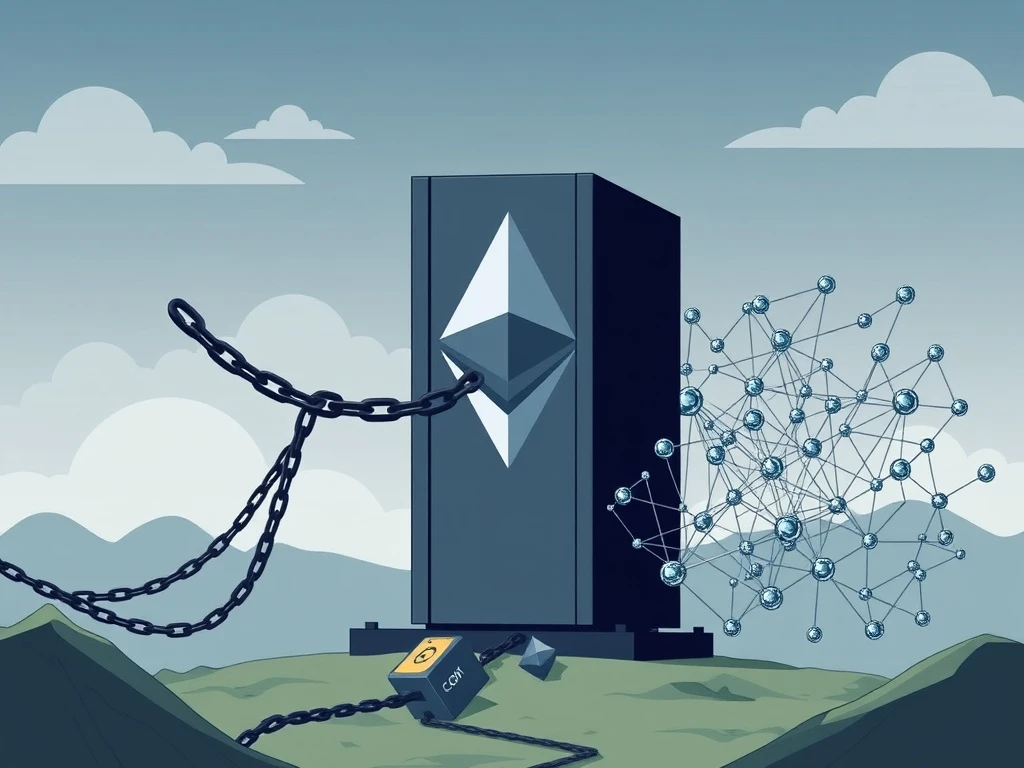Urgent Debate: Are Layer 2s Threatening Crypto Decentralization?

The cryptocurrency world constantly seeks innovation. However, a significant debate has emerged regarding the true nature of Layer 2s and their impact on the fundamental principles of blockchain. Many proponents champion Layer 2 solutions as vital for scalability. Yet, critics, like Taraxa co-founder Steven Pu, raise an urgent question: Are these solutions inadvertently eroding the very decentralization that defines crypto? This article delves into Pu’s critical assessment of rollup technology and its potential threats to the core tenets of the crypto ecosystem.
Understanding Decentralization and Layer 2s
At its core, crypto’s uniqueness stems from its **crypto trustlessness**. This quality relies heavily on a truly decentralized infrastructure, primarily found in Layer 1 networks. A decentralized system ensures that a large, randomized set of global nodes makes decisions dispassionately. These nodes are operated by diverse individuals, collectively possessing minimal connections. Therefore, this distributed control prevents any single entity from gaining undue influence. Consequently, the network remains impartial and resistant to censorship.
Steven Pu argues that this essential decentralization rests on three critical pillars:
- Inclusion: The ability for any valid transaction to be added to the network.
- Ordering: The sequence in which transactions are processed.
- Execution: The correct processing of transactions according to network rules.
A network’s decentralization is only as strong as its weakest pillar. Pu contends that when a single decision-maker controls any of these elements, the ‘trustless’ label becomes merely a marketing claim. Furthermore, he asserts that current **Layer 2s**, particularly rollups, fracture all three pillars simultaneously, compromising true decentralization.
The Centralized Nature of Rollup Technology
Today, two main types of **rollup technology** dominate the Layer 2 landscape: optimistic rollups and zero-knowledge (ZK) rollups. Most of these networks operate with a single, centralized sequencer. This sequencer holds significant power. It makes all crucial decisions regarding transaction inclusion, ordering, and execution within the Layer 2 environment. This centralized control directly contradicts the decentralized ethos of crypto.
These rollups do attempt to enforce some correctness, primarily concerning execution. Optimistic rollups, for instance, use a weeklong ‘challenge period.’ During this time, anyone can dispute a fraudulent transaction. However, this system carries inherent risks. If even one fraudulent proof persists, millions of transactions could unwind, causing chaos and locking capital. This process undermines user confidence for days.
ZK-rollups offer a stronger guarantee for execution correctness through cryptographic ZK-proofs. Nevertheless, Pu points out a critical flaw. A perfect proof of execution holds little value if a lone sequencer can still refuse, delay, or reorder transactions at will. Without transparent, immutable records of who attempted to transact and when, proving censorship becomes impossible. Consequently, punishing such actions also becomes unfeasible. If a network cannot ensure transparency, fairness, and correctness for inclusion and ordering, the guarantee on execution becomes fundamentally unreliable. Execution, after all, depends entirely on what is included and how it is ordered.
Erosion of Crypto Trustlessness and Market Impact
The market is increasingly acknowledging these concerns. Liquidity is fragmenting across various bridges. Each bridge inherits the weakest-link assumptions of its underlying rollup. This creates a complex web of custodial multisigs and emergency-pause switches. Consequently, this intricate structure introduces significant systemic risk. Traders are now actively pricing this risk into asset valuations. This ‘sequencer risk’ represents a discount applied to assets due to the centralized control within Layer 2s.
Steven Pu warns that if this discount for sequencer risk continues to widen, **Ethereum’s monetary premium** will inevitably suffer. The perceived safety and trustlessness of Ethereum, a core reason for its high valuation, could diminish. This market reaction underscores the profound impact that perceived centralization on Layer 2s has on the broader crypto ecosystem and investor confidence.
The Paradox of Decentralizing Layer 2s
A common counter-argument to the centralization critique is that **Layer 2s** will eventually achieve decentralization. Pu, however, dismisses this as a self-defeating argument. He posits a direct question: What happens if you transform a Layer 2 into a truly decentralized network of sequencers? Such a network would feature sequencers collaborating through a decentralized consensus mechanism. It would also provide strong guarantees on inclusion, ordering, and execution.
The answer, according to Pu, is simple: You end up with another Layer 1 network. Therefore, anyone suggesting that Layer 2s can eventually become decentralized is effectively stating they will evolve into new Layer 1s. This outcome would inevitably siphon liquidity, fees, and Total Value Locked (TVL) away from the original Layer 1 (primarily Ethereum) they were designed to scale. Furthermore, the current operators of profitable single-sequencer stacks would have little incentive to dilute their power and decentralize their systems. This inherent conflict of interest makes the promise of future decentralization challenging to achieve.
Prioritizing Direct Ethereum Scaling
Steven Pu advocates for a different approach: directly scaling **Ethereum Scaling**. He argues that Ethereum does not inherently need to be slow and expensive. Many newer consensus designs on existing mainnets offer valuable references. These designs could significantly improve Ethereum’s technical functionalities. Ethereum, with a TVL rapidly approaching $100 billion, understandably requires extreme caution when implementing fundamental architectural changes. However, active and focused progress is crucial.
Pu suggests that efforts should concentrate on scaling Ethereum itself, rather than solely relying on Layer 2s. He describes these Layer 2s as ‘parasitic’ if they merely role-play as decentralized networks without genuinely achieving it. Funding key upgrades in production, execution, and consensus layers would achieve several vital goals:
- It would reinforce Ethereum’s neutrality.
- It would preserve its valuable fee revenue.
- It would restore user confidence.
- It would avoid the ‘bridge-risk tax’ imposed by rollups.
Ultimately, the call to action is clear: prioritize direct Ethereum Layer 1 scaling. This strategy, Pu believes, will safeguard the foundational principles of **crypto trustlessness** and ensure the long-term health and integrity of the entire ecosystem.









